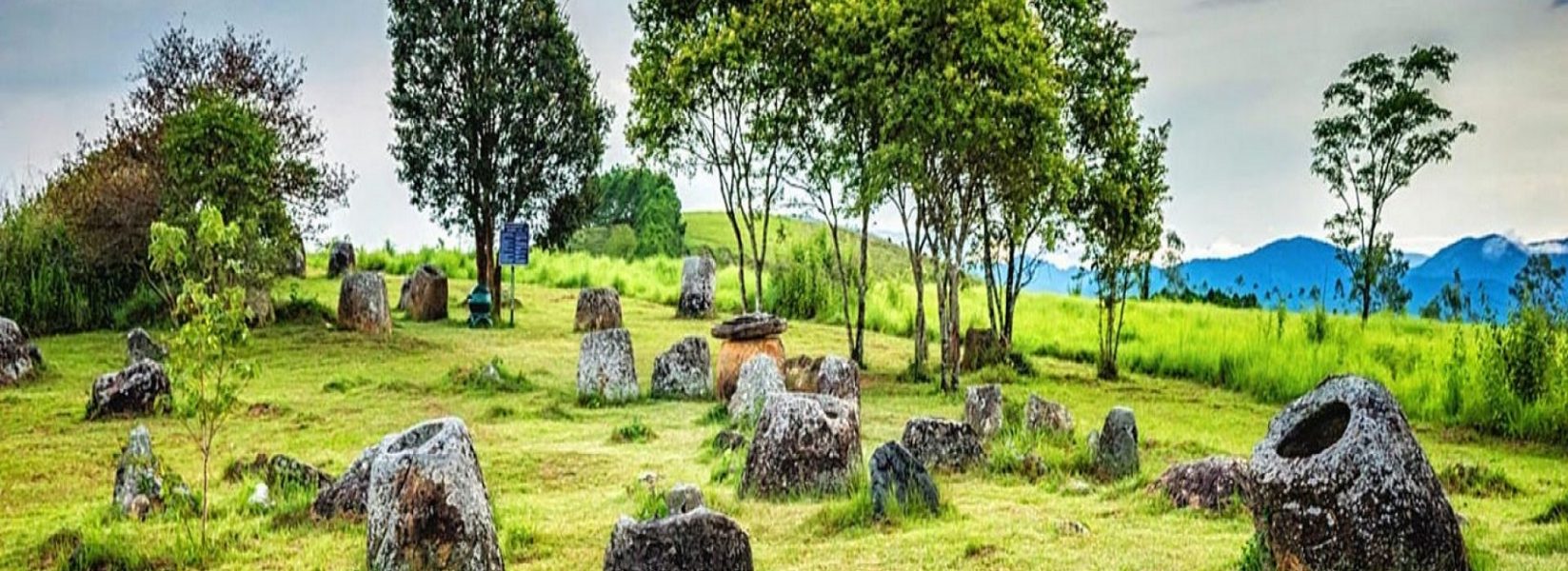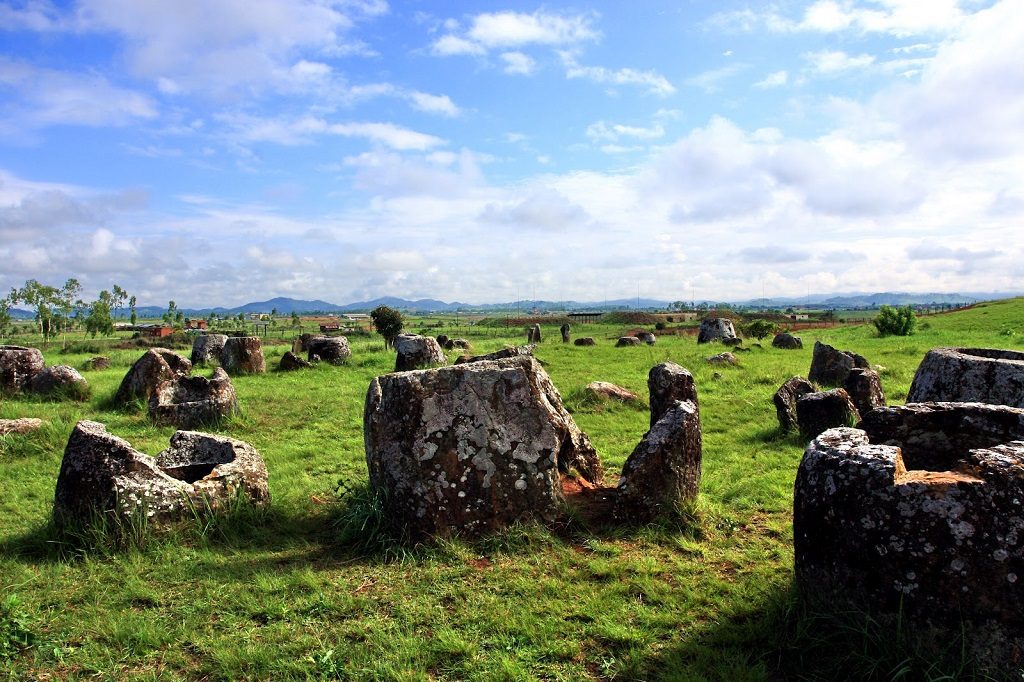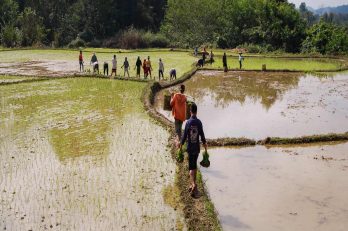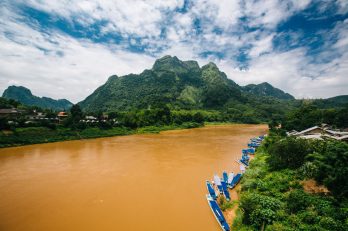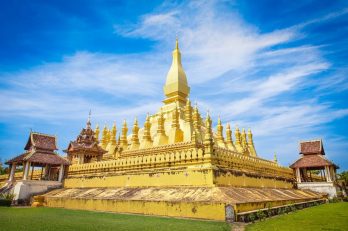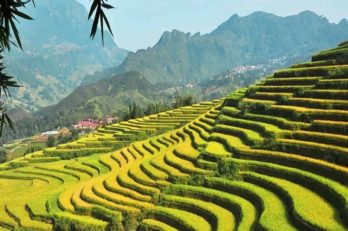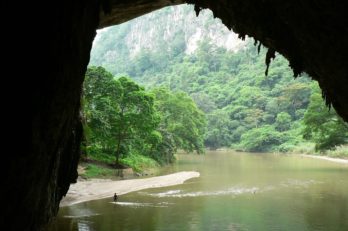Xieng Khouang – The Plain of Jars
Xieng Khouang consists of six districts Muang Khoune, Muang Phonsavanh, Muang Nong Hai, Muang Kham, Muang Mork, and Muang Phou Koud.
Situated in the northeastern remote provinces of Laos, the area was part of the Ho Chi Minh Trail, where troops, supplies and artillery were smuggled out of northern Vietnam and through the mountains on the eastern edge of the country, and subsequently into southern Vietnam.
While the vast majority of people reading this will be aware of the Vietnam War fought between 1963 to 1974, fewer know that a large part of the war was fought in Laos, giving the country the dubious title of being “the most bombed country in the world”. During the space of eleven years, the equivalent of one bomb was dropped every eight minutes. In total, two million tonnes of ordinance was dropped on Laos, more than on Germany and Japan combined during the Second World War. As a result the vast majority of sights within the province are dedicated to paying respects to the great tragedy that was inflicted on the area and its people.
Most Popular Attractions in Xieng Khouang
01 – Mulberries Organic Silk Farm
Visitors can view all the silk making process right here in the house. There are guided tours in English. If you are lucky enough, you may catch a glimpse of Miss Kommaly, who will tell you how she started this environmental-friendly cooperative 20 years ago. Her tireless work to empower local women and ethnic minority groups by raising their incomes through weaving earned her the 2005 nomination for the Nobel Peace Prize. Mulberries gift shop features beautiful plain silk scarves in a variety of rich colours, patterned throws and cushion covers and fabrics by the metre. Some patterns and home furnishing fabrics can be ordered. Mulberries Silk Farm in Xieng Khouang Province can be reached by plane from Vientiane. Lao Airlines operates three flights a week from Vientiane to Xieng Khouang. There is also a bus service from Vientiane that takes about 10 hours. If you can’t travel to Xieng Khouang, there is a Mulberries shop in Vientiane selling the same products.
02 – The silk farm
Among other things, the province of Xieng Khouang has always been synonymous with fine Laotian silk, the tradition of which dates back for centuries. Mulberries Organic Silk Farm, in the Phonsavan District of Xieng Khouang Province, is an establishment that aims to promote silk production as a way to generate income to families in surrounding areas while preserving the vanishing art of Laotian weaving. This non-profit company, certified both by Fairtrade and Lao Organic Department, grows their own chemical-free mulberry trees. Mulberry leaves are the staple diet of silk worms, which are raised here for four months, after which their silk cocoon is collected and reeled. The dyeing process that follows makes use of indigenous plants (such as indigo, jackfruit, and tamarind), which produce deep and rich colours. Once the thread is spun, it is given to village women who take them home to weave in their spare time. The silk farm then buys back the finished products to sell in their gift shops here and in Vientiane. Prior to that, the women attend workshops and learn how to make and use natural dyes, and the complex art of incorporating traditional designs into their creations
03 – The Plain of Jars
The Plain of Jars is considered the most distinctive and enigmatic of all Laos attractions. The large area around Phonsavan, the main city of Xieng Khouang Province is dotted with stone jars but no one has a clear idea as to why they are there. The mysterious jars were carved from both sandstone and granite in various sizes from very small to about 3.5 metres high and are thought to be more than 2,000 years old. Legend has it that they were made to store rice wine while some believe they were for storing the dead. Until today the function of the jars is still disputed.
Of all the many jar sites, the three most popular ones to visit are known as Site 1, 2 and 3. The main reason is because they are safe from UXO (unexploded ordinance). Still, visitors are advised to walk only on the known routes as Laos is considered the most heavily bombed/mined country in the world. During the Vietnam War this area got hit hard and some of the bombs did not go off. Site 1 is where the biggest jar is located. While Site 2 and 3 offer picturesque views of farmlands and villages as they sit on top of small hills.
04 – Muang Khan Cemetery
Unique and worth a visit just for the unusual site of mixing together Thai Dam animist tombs, Catholic headstones and Laos (Buddhist) tombs, situated east of Phonosavan.
05 – Muang Khoun
Located 30 km southeast of Phonsavan. This town was once the Royal Capital and the centre of the Phuan Kingdom. Some might describe it as a shadow of its former self and they would be quite accurate in doing so. A few French colonial buildings still remain in the town centre alongside Watt Is Phum- home to a sitting Buddha. On the outskirts the ancient stupas tower over the city and the vistas surrounding the structures are well worth the hike. A few kilometers beyond the old capital, near the village of Ban Phai, lies a jar site; the jars are located just off an old dirt road and, unlike the jars at the three main sites, strangely enough they’re built from granite.
06 – Muang Sui
Used by the Americans as a landing site for planes during the Second Indochina War, much like neighboring Muang Khoun the town has endured a gradual rebuilding process since its obliteration during the war, and is now part of the Muang Phu Kut district. Once a quaint town housing antique Buddhist temples and provincial architecture, visitors can still bear witness to some of the temple remains, in particular War Ban Phong where monks still reside.
07 – Tham Pa
These two limestone caves hid hundreds of small Buddha figures from the Haw invasion a few centuries ago. Dimly lit with the help of the rigged electrical lights (switched on by the locals for a small donation) making the passageways that link one cave to another accessible. The caves persist deep into the hill side and are pretty amazing.
That Foun (Old Xieng Khuang- Muang Khoun) This Buddhist stupa is also known as That Chomsi. It measures about 30 metres and was built in 1576. The Lanna inspired structure stands tall over the town and can be entered by a cavity left by the Chinese Ho marauders, over a century ago after they looted the stupa in order to seize valuable Buddha images enshrined within. The stupa was erected to cover ashes of Lord Buddha that were brought from India, during a time when Buddhism was proliferating in Laos. There are few if any sleeping options within this area so it is advised to take a day trip from the more populated Phonosavan.
08 – War Memorials
South of Phonosavan are two major war memorials set 1 km apart on separate hill tops. Both are set in the style of traditional Laos stupas (each containing the bones of the dead) although one is representative of the Vietnamese and the other the Laos lives lost. Inscribed on the Lao monument is the slogan ‘The nation remembers your sacrifice’, erected in 1998 a nearby slab of granite has the names of all the soldiers lost inscribed on its surface. The Vietnamese war memorial has the inscription ‘Lao-Vietnamese solidarity and generosity forever’. Both memorials enjoy sprawling views of the countryside and are especially attractive at sunset.
Have a nice trip!



